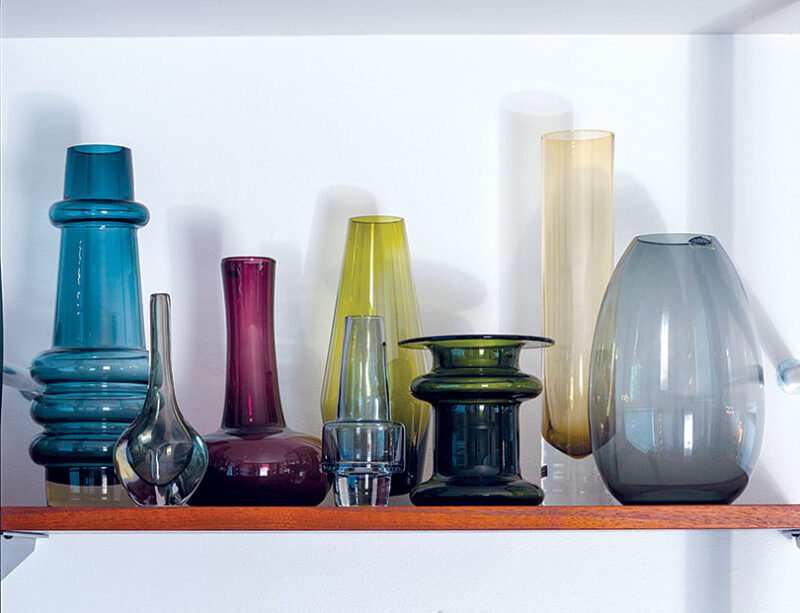The mid century saw a boom in glass making, with Modernism ushering in an era of sensuous shapes and riot of colors. From Italy to Sweden to the US, glass makers flourished, influencing each other and pushing the art forms and materials in new directions.
“The great thing about mid century glassware is it can be utilitarian, such as pitchers and candlesticks, or it can be decorative—and oftentimes, it is both, such as with a vase,” observes Ruby Lane Chief Marketing Officer Gisele Barrau-Freeman. “That’s why it’s so popular with collectors. In fact, vintage glass has been increasing as a sought-after MCM trend.”
When shopping for mid century glass, there are a few things to consider:
- Color. Are you looking for something neutral or for a burst of multihued glory? Scandinavian glass tends to be less colorful than Italian glass, for example. Think about what will complement the MCM décor in your room. Many glass aficionados gravitate toward a specific color and build a collection from there.
- Form. Are you looking for something exuberant or more restrained? Linear or curvaceous? MCM pieces come in a multitude of styles, so think about a specific place in your home or use to help you narrow down the selections.
- Price. MCM glass tends to be quite affordable and is available at a variety of price points. Of course, for special pieces, unique one-offs, or creations by master glassmakers, prices will be significantly higher.
- Maker’s mark. Some pieces of MCM glass are not marked but tracking down the piece’s history can be half the fun. Books such as “Mid Century Modern Glass in America” by Dean Six and Paul Eastwood will help you suss out manufacturers and dates, as well as decipher trademarks and symbols.

In search of authentic MCM glassware, I turned to Ruby Lane, and found many examples of MCM glass. Check these out:
Scandinavian Glass from the Mid Century
Just as Danish, Finnish and Swedish wooden furniture greatly influenced the MCM era, so, too, did the region’s glass creations. While Scandinavian MCM glass can be colorful, it is often associated with clear, or lighter colored glass, such as smokey gray—it’s as if the cooler climate translated into ideas of ice and clarity in the work. Designs created post-World War II are considered the most desirable by collectors. Look for storied brands like Orrefors, among many others.

Fun fact: Holmegaard Glass Factory has an interesting history: the company was founded in 1825 by Countess Henriette Danneskiold-Samsøe and is still in business today.
Italian Glass from the Mid Century
Exuberant. That’s the best way to sum up mid century glass made in Italy. It’s often very colorful, as seen in tutti frutti designs, and can be whimsical, such as glass fish seemingly suspended within clear “water” made from glass. Murano, part of a group of islands north of Venice, is synonymous with Italian glass expertise and has been a center of the craft since the 13th century.

Bonus tip: Give a living room or bedroom some MCM flair with a glass Italian lamp like this one:

American Glass from the Mid Century

Who can resist the organic shapes, tower-like pieces and candy colors of mid century American-made glass? American glass makers were spread around the country in places such as West Virginia, New York and Ohio. Manufacturers include Blendo, Blenko, Fenton, and of course, all the cookware and dinnerware from Corning, among other makers.
Blendo
With its colorful, frosted ombre treatment, Blendo glassware stands out. Blendo was produced by Anchor Hocking Glass Corp. and West Virginia Glass Co. Look for tumbler glasses, juice sets with pitchers, salad bowls and even martini shakers.

Blenko
Based in Milton, West Virginia, Blenko is known for its vivid use of color in handblown tableware and decorative glass. Begun in 1893, the company is still alive today. Collectors use books of catalog reprints to better identify vintage pieces of Blenko, as many pieces did not have a maker’s mark and instead were sold with a simple sticker.

Bonus tip: Want more on these two types of glassware? Read “Which Is Which? Blendo Vs. Blemko” in the Atomic Ranch archives.
Lastly, once you’ve shopped for your MCM glass, consider displaying it on a shelf in front of a window, inside a lighted cabinet, or on top of open shelving. Light plays through glass in such a delightful and unique way.
Looking for more tips on authentic mid century style? Check out Set the Scene for a Mid Century Modern Garden Party. Follow Ruby Lane on Instagram, Facebook and Pinterest for more Mid Century Modern inspiration!











